We included HMH Into Math Grade 7 Answer Key PDF Module 14 Lesson 1 Understand Probability of an Event to make students experts in learning maths.
HMH Into Math Grade 7 Module 14 Lesson 1 Answer Key Understand Probability of an Event
I Can describe the likelihood of an event.
Spark Your Learning
A gumball machine contains 50 gumballs. There are 25 blue, 10 red, 12 green, and 3 yellow gumballs in the machine. Bart puts a coin in and turns the wheel to receive a gumball. What is an outcome that is likely to occur? Not likely? As likely as not? Certain? Impossible?
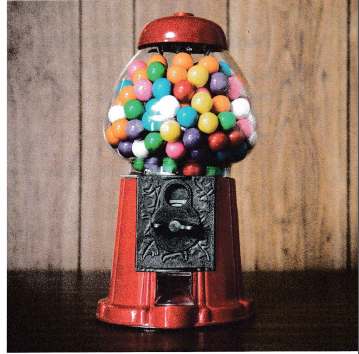
Answer:
Turn and Talk How would you describe the likelihood of receiving a red gumball, using the given phrases? Explain.
Answer:
Build Understanding
Connect to Vocabulary
The probability of an event measures the likelihood that an event will occur.
Probability describes how likely an event is to occur. It is a measure between 0 and 1 as shown on the number line, and can be written as a fraction, a decimal, or a percent. The probability of an event is written as P(event).
The closer the probability of the event is to 0, the less likely the event is to occur. The closer the probability of the event is to 1, the more likely the event is to occur. An event with probability 0 is impossible. An event with probability 1 is certain.

Question 1.
Tell whether each event is impossible, unlikely, as likely as not, likely, or certain. Then tell whether the probability is 0, close to 0, \(\frac{1}{2}\), close to 1, or 1.
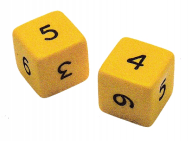
A. A bag contains pieces of paper labeled with the numbers 1 through 100. A piece of paper with the number 13 is selected at random.
Answer:
B. Two standard number cubes are rolled. The sum of the numbers is 1.
Answer:
C. A standard number cube is rolled, and the result is an even number.
Answer:
D. A bowl contains 26 disks. Each disk is labeled with a different letter of the alphabet. A consonant is selected at random.
Answer:
E. Twelve middle-school students are selected to complete a survey. None of the students are in tenth grade.
Answer:
Turn and Talk What do you know about the value of the probability of an event that is likely? Explain.
Answer:
Connect to Vocabulary
An experiment is an activity involving chance in which results are observed.
Often the same experiment is repeated many times. Each repetition of an experiment is called a trial, and each result of a trial is an outcome. A set of one or more possible outcomes for a trial is an event. A sample space is the set of all possible outcomes for an experiment.
Question 2.
Roll a number cube 10 times. How likely is each event in the table?
A. What is the sample space of all possible outcomes when you roll the number cube once?
Answer:
B. Roll a number cube 10 times and record the number of times each event occurs in the table.
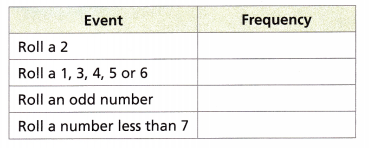
Answer:
C. How many trials did you perform? How many events did you record?
Answer:
D. Judging from the results of your trials, which events are certain when rolling a number cube?
Answer:
E. Judging from the results of your trials, which events are likely? Which events are unlikely? Which events are as likely as not?
Answer:
Turn and Talk Based on your results from the table, what number or number range might you use to describe the probability of rolling a 2? Explain.
Answer:
Check Understanding
Question 1.
Tell whether choosing a blue marble from a jar containing 4 blue marbles and 12 red marbles is unlikely, as likely as not, or likely. Is the probability closer to 0 or 1?

Answer:
Given,
A blue marble from a jar containing 4 blue marbles and 12 red marbles
P = 12/4 = 3
It is unlikely because there are 3 times more red marbles than blue marbles.
Question 2.
What number and what percent describe the probability of a certain event? What number and what percent describe the probability of an impossible event?
Answer:
On Your Own
Question 3.
Mina opens a book 15 times and records whether the page number is even or odd. How many trials did she conduct? Name two events that she recorded.
4Answer:
Question 4.
Krisha has a bowl with 12 green disks and 8 yellow disks. Is the probability of randomly selecting a green disk unlikely, as likely as not, or likely?
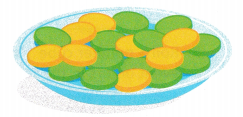
Answer:
Question 5.
Reason A container holds 20 red, 20 blue, and 10 green marbles. Is the probability of choosing a blue marble greater than or less than the probability of not choosing a blue marble? Explain.
Answer:
The probability of choosing blue marble is less than the probability of not choosing a blue marble.
Explanation:
20 + 20 + 10 = 50 marbles
The reasoning for this is that there is a total of 50 marbles and only 20 of the 50 are blue.
That means 30 are not blue marbles. Since 30 is bigger than 20 there are more non-blue marbles than there are blue marbles. The probability of choosing a blue marble is less than the probability of not choosing a blue marble.
For Problems 6-7, describe the probability of each event in words. Then describe each probability with a number or a number range.
Question 6.
Roll a number greater than 5 on a standard number cube.
Answer: There are 6 numbers on a standard dice.
1, 2, 3, 4, and 5 are less than or equal to 5.
So, the only number greater than 5 is 6.
So, the probability is 1/6.
Question 7.
Pick a number less than or equal to 30 from a bag with 40 pieces of paper numbered 1 through 40.
Answer:
Pick a number less than or equal to 30 from a bag with 40 pieces of paper numbered 1 through 40.
30/40 = 3/4 = 75%
Thus 75% of chance of picking a number less than or equal to 30.
Question 8.
Open-Ended Ask 6 students their age and record the results. Pick one age from the results. How many students stated this age? Describe in words the probability that a student in your class is this age, judging from the results.
Answer:
I’m in a Learning Mindset!
Did I select appropriate challenges as part of learning how to describe the probability of an event?
Answer:
Lesson 14.1 More Practice/Homework
Question 1.
Roberta rolls two standard number cubes. Tell whether a sum greater than 12 is impossible, unlikely, as likely as not, likely, or certain.
Answer:
The maximum of the sum is 12
6 + 6 = 12
The sum cannot be greater than 12.
So, the event is impossible.
Question 2.
A machine makes 50 parts. Out of the 50 parts, 3 are defective. Using a number or a number range, describe the probability that a randomly selected part is not defective.
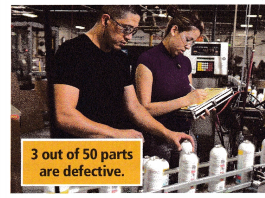
Answer:
Given,
A machine makes 50 parts.
Out of the 50 parts, 3 are defective.
Subtract 3 from 50.
50 – 3 = 47
47/50 = 0.94
0.94 can also be written as 94%
Question 3.
Open-Ended Write a situation where the probability of an event occurring is unlikely.
Answer:
Question 4.
Rocky has a box of pens. He has 11 black pens, 8 blue pens, and 6 red pens. He randomly selects a pen from the box. Describe the probability that the pen he selects is blue, using a number or a number range.
Answer:
Flip a coin eight times and record the results of heads or tails. Use the results for Problems 5-9.
Question 5.
List the sample space of all possible outcomes when you flip a coin once.
Answer:
The sample space of a fair coin flip is {H, T}
A sample space is the set of all possible outcomes of a random experiment. When you toss a coin, there are only two possible outcomes-heads (H) or tails (T) so the sample space for the coin toss experiment is {H, T}
Question 6.
What experiment did you perform? How many trials of the experiment did you conduct? What events did you record?
Answer:
Question 7.
How many times did the coin land heads up? Based only on these results, does getting heads seem to be impossible, unlikely, as likely as not, likely, or certain?
Answer:
Question 8.
How many times did the coin land tails up? Based only on these results, does getting tails seem to be impossible, unlikely, as likely as not, likely, or certain?
Answer:
Question 9.
Reason Are the results of your experiment what you would expect? Explain.
Answer:
Test Prep
Question 10.
Adam has 10 blocks numbered 1 through 10. Which describes the probability of randomly choosing a block that has an even number?
(A) impossible
(B) unlikely
(C) as likely as not
(D) likely
(f) certain
Answer:
Adam has 10 blocks numbered 1 through 10.
1, 2, 3, 4, 5, 6, 7, 8, 9, 10
There are 5 even numbers.
P = 5/10 = 1/2
So, it is likely possible.
Option D is the correct answer.
Question 11.
Bella finds some beach glass. She finds 14 pieces of brown beach glass, 12 pieces of white beach glass, 12 pieces of green beach glass, and 2 pieces of blue beach glass. She lets her sister pick one piece at random to keep. Describe the probability, using a number or a number range, that her sister picks a piece of blue beach glass.
Answer:
Question 12.
A bowl contains 4 blue marbles and 12 red marbles. Soo-jin picks a marble from the bowl. Describe a likely event.
Answer:
A bowl contains 4 blue marbles and 12 red marbles.
Total number of marbles in the bowl = 4 + 12 = 16
Soo-jin picks a marble from the bowl = 1
So, the probability is 1/16.
Question 13.
A community service club has 12 seventh-graders and 12 eighth-graders. The name of each student is put in a hat, and a name is drawn at random. Which number or number range describes the probability that the student selected is an eighth-grader?
(A) a number greater than 0 and less than \(\frac{1}{2}\)
(B) a number greater than \(\frac{1}{2}\) and less than 1
(C) 1
(D) \(\frac{1}{2}\)
Answer:
Given,
A community service club has 12 seventh-graders and 12 eighth-graders = 12 + 12 = 24
The probability that the student selected is an eighth-grader is \(\frac{12}{24}\) = \(\frac{1}{2}\)
Thus option D is the correct answer.
Spiral Review
Question 14.
A patio is shaped as a composite figure consisting of two rectangles. One part of the patio is 20 feet long and 15 feet wide. The other part is 15 feet long and 10 feet wide. What is the area of the patio?
Answer:
Given,
A patio is shaped as a composite figure consisting of two rectangles.
One part of the patio is 20 feet long and 15 feet wide.
We know that,
Area of a rectangle = l × b
A1 = 20 × 15 = 300 sq. feet
The other part is 15 feet long and 10 feet wide.
We know that,
Area of a rectangle = l × b
A2 = 15 × 10 = 150 sq. feet
Total A1 + A2 = 300 + 150 = 450 sq. ft
Thus the area of the patio is 450 sq. ft
Question 15.
An aquarium is a rectangular prism. The volume of the aquarium is 6,480 cubic inches. The length of the aquarium is 30 inches, and the height is 18 inches. What is the width of the aquarium?
Answer:
Given,
An aquarium is a rectangular prism.
The volume of the aquarium is 6,480 cubic inches.
The length of the aquarium is 30 inches,
Height is 18 inches.
V = lbh
6480 = 30 × b × 18
b = 6480/540
b = 12 inches
Thus the width of the aquarium is 12 inches.